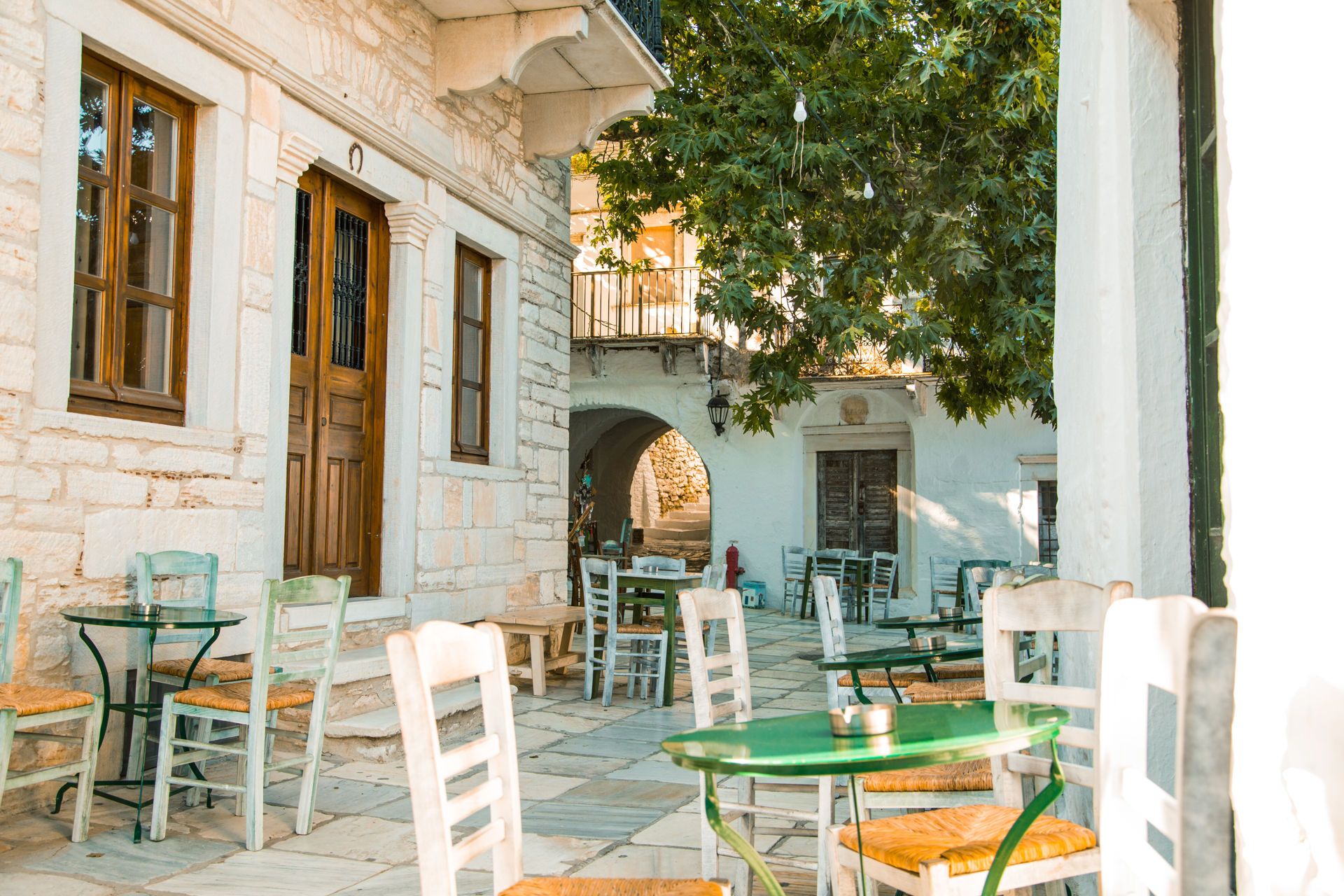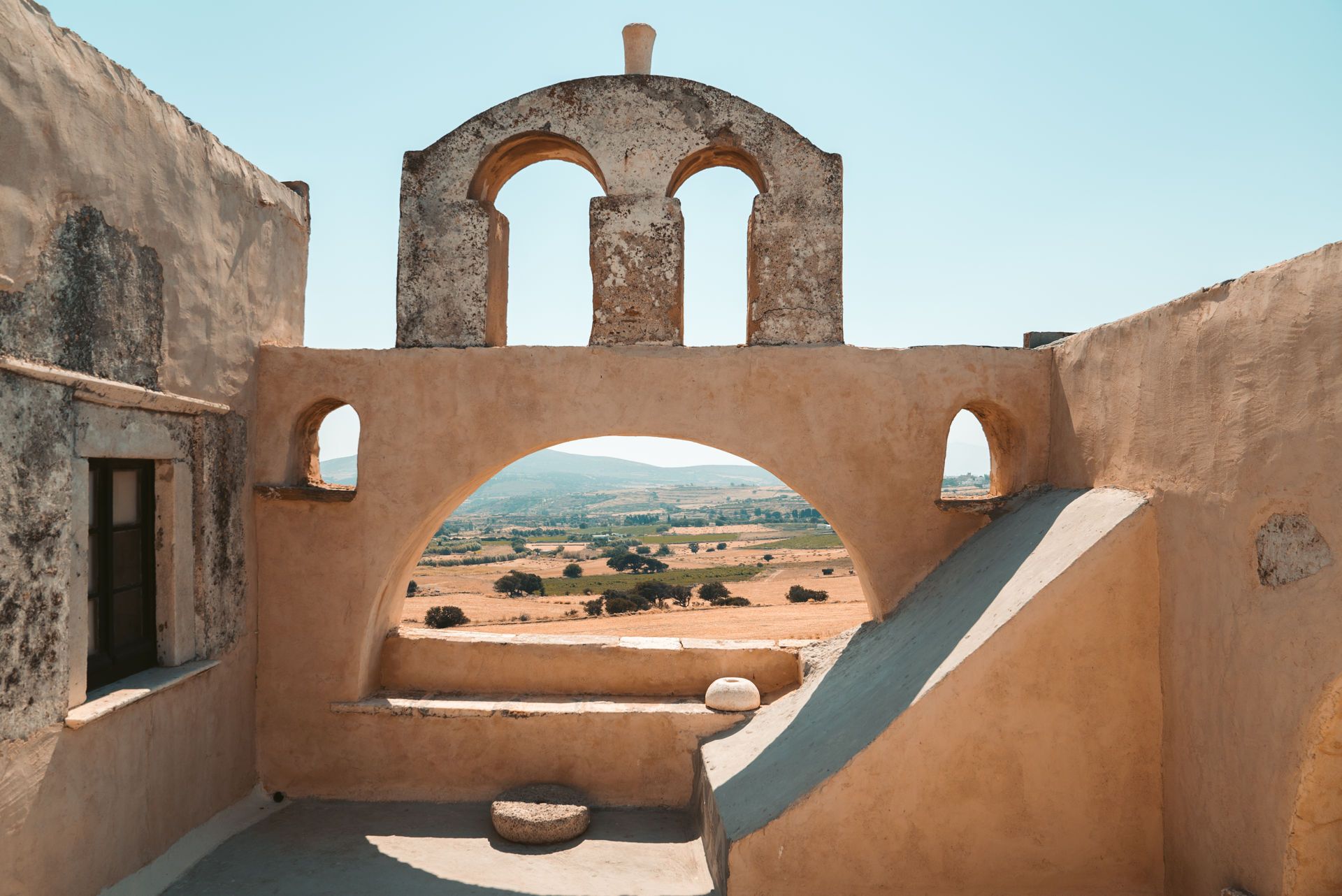
Naxos
Located in the heart of the Aegean, Naxos is an island with a long history and notable contribution to the creation of Greek civilization. Naxos has been inhabited since prehistoric times. Zeus, father of the Greek gods, was born on Crete but raised on Naxos; the island’s highest peak, Za, with an altitude of 1004 meters, takes its name from him. Dionysos, the god of wine, lay on Naxos with Ariadne, goddess of fertility. The fertility of the island is credited to their union. Even though the island today has considerable tourist development, locals also engage in other industries including agriculture, stockbreeding, marble quarrying, and trade.
Naxos has the cosmopolitan air of a modern tourist resort but also retains its traditional color and its folk culture. The seemingly endless shoreline lapped by clear waters and shaded by cedars that extend along the southern and southwestern coasts, as well as on the island’s northern side, harbor spots of incredible natural beauty and alluring landscapes. Devotees of windsurfing will love the island for the unique conditions it offers for their favorite sport. The meltemi, or summer winds that blow during the daytime, are their best ally.
For cycling aficionados, Naxos offers unique routes while hikers and nature-lovers will find the island satisfies their passion for exploring. The island is a veritable paradise with scores of paths crossing it. Visitors interested in learning about the day to day lifestyle of the island and its folk culture should explore its interior where visitors are welcomed as honored guests. The island is also a trove of culture and history, with a number of noteworthy monuments concentrating relics representing a range of period. It’s also an excellent summer holiday destination for those for whom vacations are synonymous with nightlife as Hora in summer doesn’t sleep.
History
Stone Age. Archaeological finds attest to the existence of a developed society as early as the fourth millennium B.C.; Naxos has been inhabited continuously since.
Bronze Age (3200-1100 B.C.). Naxos is a strong presence in the Aegean during the third millennium B.C. as it emerges as an important center of the so-called Cycladic culture. Excavation finds from this period are exhibited at the Archaeological Museum of Naxos in Hora and the archaeological museum of Apeiranthos.
At the dawn of the second millennium B.C., the Minoans are the dominant maritime power in the Aegean, and later control of the seas passes to the Mycenaeans. The centers of power shift to the Mycenaean centers on the Greek mainland which use the Cyclades as bridges in their expansion to the east. One section of the Mycenaean capital of Naxos (1300 B.C.) was uncovered beneath the square of the cathedral in Hora at the archaeological site of Grotta.
Geometric era (1100-700 B.C.). Naxos is colonized by the Ionians, and their arrival marks the start of a period of tremendous growth.
Archaic era (700-480 B.C.). The island reaches its peach in the seventh and sixth centuries B.C., a period during which the arts-especially sculpture and architecture-flourish thanks, in part, to the abundance of marble on the island. Typical of the island’s sculptures are the two larger-than-life, half-completed kouroi founded at Melanes and Apollonas. Excavations have also unearthed important works from this period, notably the temple of Yria, south of Hora at Livadi, and the sanctuary of Yiroula near Sagri. The temple of Apollo, or Portara on Palataki islet at the port’s edge, also dates from this period. In 490 B.C., Naxos is destroyed by the Persians.
Classical era (480-323 B.C.). Following the Persians’ defeat, Naxos becomes a member of the Athenian League.
Hellenistic era (323-41 B.C.). One of the island’s most important monuments, the Himarros tower, dates from this period. The tower is located near the village of Filoti; another ancient tower is Palaiopyrgos, located between Tripodes and Plaka beach.
Roman era (41 B.C.-A.D. 330). In 41 B.C. Naxos becomes a Roman province and is used as a place of exile.
Byzantine era (330-1207). The advent of Christianity in the fourth century leads to the construction of many churches over ancient temples. Today, there are more than 500 churches on the island. Panayia Drosiani near Moni and Panayia Protothroni near Halki are two important monuments of the Early Christian period. The fortified monastery of Fotodotis Christos on the outskirts of Danakis also dates from this period. The Byzantines also built castles or fortifications on the island. One example is the Kalogeros Kastro which is built atop a low but inaccessible hill on the island’s northern end. Apano Kastro is located west of the Tragea plain. The Apalirou Castle in the central Naxos is built atop a sheer slope; the island’s Byzantine capital was located at its foothills.
Venetian rule (1207-1537). In 1207, Marco Sanudo lands with his men at Ayiassos and after a siege conquers the island. He subsequently conquers 18 more islands in the Aegean, then founds the Duchy of Naxos, with the island as its seat, and creates a small feud. The capital is moved from Apaliros to Hora, whose hill forms a natural acropolis. On this site, Sanudo built Hora’s fortified castle using materials from the ancient city. The island’s rulers built their towers around and outside it for protection or for summer housing. There are also a number of more recent towers on the island’s northern coast, such as the Ayia Pyrgos which dates from the 17th century but was destroyed by fire, and the fortified monastery of Panayia Ypsilotera on the outskirts of the village of Galini.
Turkish rule (1537-1829). Naxos remained under the Turkish yoke until 1829 when it joined the modern Greek state.
Modern times. The emery mines on the island’s eastern section, along the road to Liona, are one of the island’s modern monuments. Today, the island’s farm products provide it with economic self-sufficiency. Tourism has been developed since the 1980s.
Sights
Hora is the island’s capital, its administrative center, and its harbor. It offers all modern conveniences year-round. A number of monuments in Hora, such as Portara, the archaeological site of Grotta, and the Venetian castle, attest to its past. The archaeological museum and Vassilis and Kathy Koutelieris folk museum collection are located in Hora. In summer, holidaymakers flock to Ai Yioryis beach, a long stretch of sand to Hora’s south, while some swimmers prefer the waters at Grotta beach, to Hora’s north, just beyond the port. Local products are sold in the market, alongside folk art, artifacts, clothing, and jewelry. There are dozens of restaurants and taverns where visitors can sample local dishes, as well as a range of establishments catering for all types of nightlife. There is regular public transportation from Hora to all villages and beaches.
Halki. Located in the middle of the Tragea plain, Halki is the administrative center of the second largest settlement on the island-the municipality of Drymalia, which includes the villages of Tragea and mountain areas. Tragea is fertile and densely cultivated with olives and other fruit trees; since antiquity, it has been one of the most fertile and productive parts of the island. The plain is ringed by a number of villages-Kaloxylos, Akadimoi, Heimarros, Tsikaliaro, Damarionas, and Damalas. The area is known as the “Little Mystras” because of the large number of churches located there, most dating from the sixth through the 14th century.
Damarionas. Many of the old mansions in this village are being renovated. Locals are occupied with olive cultivation, agriculture, and stockbreeding. The old church of Christos in the center of the village features a wood carved iconostasis and old icons.
Damalas. A small picturesque village with a few permanent residents. It’s worth visiting the renovated traditional olive press at Damalas and the traditional ceramics workshop.
Moni. The village is built on a slope with a vie woven the Tragea plain. It is named after the church of Panayia Drosiani, which was founded as a monastery and was famous for its tapestries.
Kinidaros. A pretty village that produces a range of products from its stock farming activities. It also attracts large crowds with its paniyiri. The spring that supplies Hora’s water is located near Kinidaros, while there are also marble quarries in the area. In summer, there is considerable revelry in the open-air tavernas.
Melanes. The village is built in a fertile valley with running water that once powered watermills. The hamlets of Kouroynohori and Myloi are located here. The Fraggopoulos Tower attest to its importance as a fief during Venetian rule. One of two ancient, half-finished kouroi lays outside Flerio near Melanes.
Potami. Comprised of three hamlets-Ano Potami, Mesi Potami, and Kato Potami-built along a verdant valley among orchards with old watermills, the area is ideal for walking or hiking.
Sagri. Built on a fertile plateau planted with olives and located eleven kilometers southeast of Hora, Sagri has a number of sights such as the fortified monastery of Timios Stavros, founded in the 16th century; the monastery of Ayios Eleftherios; the Byzantine churches of Ayios Nikolaos and Ayios Artemios, dating from the eighth and ninth centuries and built during the iconomachy; and, the Somaripa tower at Kato Sagri. South of the village, at Gyroula, is an archaic temple dedicated to Demeter.
On the 12th Km of the main road linking the capital city of Naxos (Chora), with Sagri, the Bazeos Tower dominates the land leading to the seacoast of Agiassos.
Filoti. From Tragea, the road climbs to Za, the highest peak in the Cyclades (alt. 1,004 meters). Filoti is built amphitheatrically at its foothills and is one of the largest villages on the island, boasting restaurants, coffee houses, bars, and a market. The village church, Panayia Filotissa, is one of the prettiest on Naxos with rare icons, a marble iconostasis, and sculpted bell tower. Local sights include the Barozzi tower. The road from Filoti leads to the Himarros tower.
Danakos. A small village built at the base of a ravine with lots of running water that once powered watermills. The Fotodotis Monastery is located near the village amid a gorgeous setting; it’s the island’s oldest monastery. From the church of Ayia Marina, at the turn off to Danakos, a path sets off for the Za’s peak.
Apeiranthos. Apeiranthos is built in the heart of mountainous Naxos at the foot of Mount Fanari. It’s also known as the marble village and preserves intact the architecture of the Venetian era. Apeiranthos is distinguished from other villages by dialect and customs. Locals trace their roots to the mountain villages of Crete, from where their ancestors migrated in the 17th century; they are said to have a bent for poetry and the arts, while the women are especially skilled weavers. The 17th-century Zevgeli Tower built atop a rock at the village’s entrance is quite impressive. Coffee houses and tavernas serve local wine from mountain-grown vines. There are a number of noteworthy Byzantine churches in the area. Worth visiting are the village’s 4 museums:
- The Archaeological Museum,
- the Geological Museum of Apeiranthos,
- the Folklore Museum of Apeiranthos,
- and the Natural Science Museum.
Keramoti. Famous for its wine and honey, the village is marked by the church of Stavros and offers a vantage point for surveying the island’s eastern and western shores.
Koronos. The village is built in a valley by the eastern foothills of Mount Koronos at an altitude of 540 meters. Quaint and colorful, it was once the heart of the local emery industry but since the mines closed, activity has dwindled as many locals migrated to other areas. Coffee houses and taverns serve wine from mountain-grown vines. There is an ethnographic museum, while the church of Panayia Argokoilotissa just outside the village attracts thousands of pilgrims with its paniyiri.
Skado. A pretty mountain village built on a vine-covered slope.
Galanado. A picturesque village set along the Tragea road, about eight kilometers from Hora. Locals are occupied mainly in agriculture and stockbreeding. The Venetian-era Belonia tower rises just outside the village by the church of Ayios Ioannis.
Glinado. A lively market village with a number of tavernas and developed stock keeping marked by the church of Ayios Nikodimos, the island’s patron saint. At Kampos, between Glinado and the coast, an ancient temple dedicated to Dionysus was found at Yria.
Ayios Arsenios. A village marked by pretty houses with well-kept gardens. It’s worth visiting the church of Ayios Spyridon, while around the village are a number of pretty chapels and the monastery of Ayios Ioannis Prodromos.
Tripodes. A pretty village with paved lanes and abandoned windmills. The church of Panayia features a fine wood-carved iconostasis and rare icons. The ruins of the Palaiopyrgos are visible on the road to Plaka beach.
Eggares. A pretty, verdant village east of Eggares valley, about eight kilometers northeast of Hora. It’s worth visiting the Eggares Olive Press, the Pradouna tower and Faneromeni Monastery; there are two artificial dams in the area, one at Eggares and one, under construction, at Faneromeni.
Galini. A small village marked by pretty homes built in the Eggares valley, about seven kilometers northeast of Hora. The fortified monastery of Ypsilotera rises between the village Amiti beach; during Frankish rule, local farmers sought shelter there.
Beaches
Ayios Yeoryios: The most popular and most visited beach near Hora, it is sandy, with shallow waters and sheltered from winds, thus ideal for families with young children. Facilities include organized water sports, tavernas, and bars.
Ayios Prokopis: Well-known organized beach framed by all types of shops. The beach features coarse sand and clear waters. There are water sports facilities. Bus links to Hora every 20 minutes in summer, from early in the day until late at night.
Ayia Anna: A seemingly endless sand beach, Ayia Anna extends from Ayios Prokopis. It is highly developed with water sports. It’s distinguished by a cedar wood along the shore.
Plaka: A four-kilometers stretch of sand that extends from Ayia Anna. A dirt track separates the beach from the plain. Facilities include tavernas and bars.
Mikri Vigla: Essentially two fine sand beaches, Mikri Vigla and Parthenos, separated by the Mikri Vigla outcrop. Parthenos is a meeting point for surfers from around the world. There are some tavernas.
Kastraki: A three-kilometers stretch of fine pale sand; the adjacent hamlet offers some tavernas.
Alyko: Dunes and a cedar wood create an exotic landscape. The beach is generally uncrowded and there are tavernas in the area.
Pyrgaki: The last stop on the road leading south from Hora. The beach is tranquil, with soft dunes and a cedar grove; there are some tavernas.
Ayiassos: A sandy cove with shallow, clear waters. Access is by dirt track, either from Pyrgaki or from Sagri. There is a small settlement with a taverna.
Apollonas: A pretty fishing village built in a small bay on the northeastern coast. The village is somewhat developed from tourism, and linked to Hora by a new coastal road. There is a broad sand and pebble beach with seaside tavernas. The Apollonas kouros is located just outside the village.
Lionas: Access is by a winding road from Koronos that leads past the emery mine entrances. The beach is shingle with deep, clear waters. There is a small settlement with waterside tavernas.
Moutsouna: Picturesque coastal settlement with pretty sand shore and quaint tavernas located by the water on the eastern coast of Naxos. It’s the island’s only natural harbor and is located 38 kilometers from Hora. Access is via winding road that sets off from Apeiranthos.
Psili Ammos: Dunes and cedar groves create the idyllic setting of this beach, reached via coastal dirt track leading south from Moutsouna.
Kalanto: A wonderful sheltered sand beach at the island’s southernmost tip, reached either by boat or by rough road from Filoti. Bathers should take along basic provisions such as water.
Abram: A cozy sand beach with clear, warm waters-possibly the result of a warm current-on the northwestern coast, with a northern exposure. There is a small hamlet and taverna.
Amiti: Reached at the end of the road from Galini, this uncrowded beach features pale white sand. Bathers should beware of strong currents and undertow, especially if swimming with children. There is a small snack stand.
source : Tourism in Cyclades




